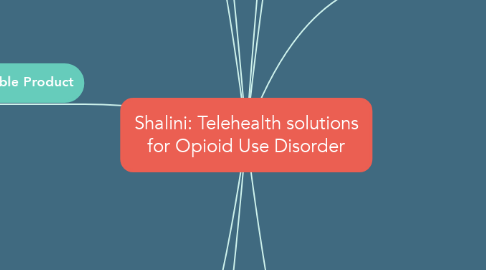
1. Goal
1.1. Develop and deploy innovative Telehealth Solutions to Reduce Opioid Use Disorder
2. Telehealth Objectives (Innovation Plan)
2.1. Prevention
2.1.1. Provider training
2.1.1.1. Reduce Improper prescription
2.1.1.2. Increase OUD diagnoses
2.1.1.3. Promote alternate pain management
2.2. Treatment
2.2.1. Patient Outreach
2.2.1.1. Identify individuals in need
2.2.2. Increase Access
2.2.2.1. Overcome physical, financial and psychological barriers
2.2.3. Patient choice
2.2.3.1. Medication Assisted Treatment (MAT)
2.2.3.2. Behavioral health
2.2.3.3. Care Coordination
3. Minimally Viable Product
3.1. PROVIDER TRAINING
3.1.1. Peer-Peer Education
3.1.2. Alternative pain strategies
3.1.3. Specialist Support
3.1.4. Identify and Manage OUD patients
3.2. PATIENT OUTREACH
3.2.1. Care Management
3.2.2. Behavioral Health
3.3. OUD TREATMENT
3.3.1. Telehealth Visits
3.3.1.1. MAT
3.3.1.2. Behavioral health
3.4. INFORMATICS CORE
3.4.1. Prescription Analytics
3.4.2. Predictive Modeling
3.4.3. Patient OUD Risk score
3.4.4. Calculated Metrics
4. Tests/Metrics
4.1. Pre-Post Training Surveys
4.2. Needs Assessment: Focus groups and interviews
4.3. CME Credits
4.4. # Primary Care Providers trained
4.5. # Patients outreached, enrolled, educated, referred
4.6. Telehealth Satisfaction Surveys
5. Feedback/Changes
5.1. What data have you collected?
5.1.1. Brainstormed with Physicians
5.2. What is the Unique Feature?
5.2.1. Informatics Core Added
5.3. How will you finance?
5.3.1. Payer savings
5.3.1.1. Cost Reducticon
5.3.1.2. Utlization reduction
5.3.1.3. Health Outcomes
6. Target Population (Users)
6.1. Navajo youth of Arizona
6.1.1. High rate of Opioid Overdose death
6.1.2. Underserved rural population
6.1.3. Disproportionate socioeconomic issues
7. Care Setting (Buyers)
7.1. Public health outreach
7.1.1. Increase ease of access
7.1.1.1. Address underserved areas
7.1.2. Address stigma
7.1.2.1. Offer privacy of remote access
7.1.3. Alternates to Rehab
7.1.3.1. Comfort of home
7.2. Behavioral health intervention
7.2.1. Access to mental health provider
7.2.2. Crisis management
7.2.3. 24 hour hotline
7.3. Substance Use Provider
7.3.1. Online MAT authorization
7.3.2. Ease of scheduling and wait time
7.3.3. Leverage new telehealth policies
8. Stakeholders
8.1. Patients
8.1.1. Improved health outcomes
8.2. Providers
8.2.1. Expand coverage and access
8.3. Caregivers
8.3.1. Reduce burden
8.4. Payers
8.4.1. Health care payers
8.4.2. Grant agencies
8.5. Public Health agencies
8.5.1. Address Opioid epidemic
8.6. Tribal leadership
8.6.1. Enhanced healthcare quality of life
8.7. Policymakers
8.7.1. Payment policy to support innovation
